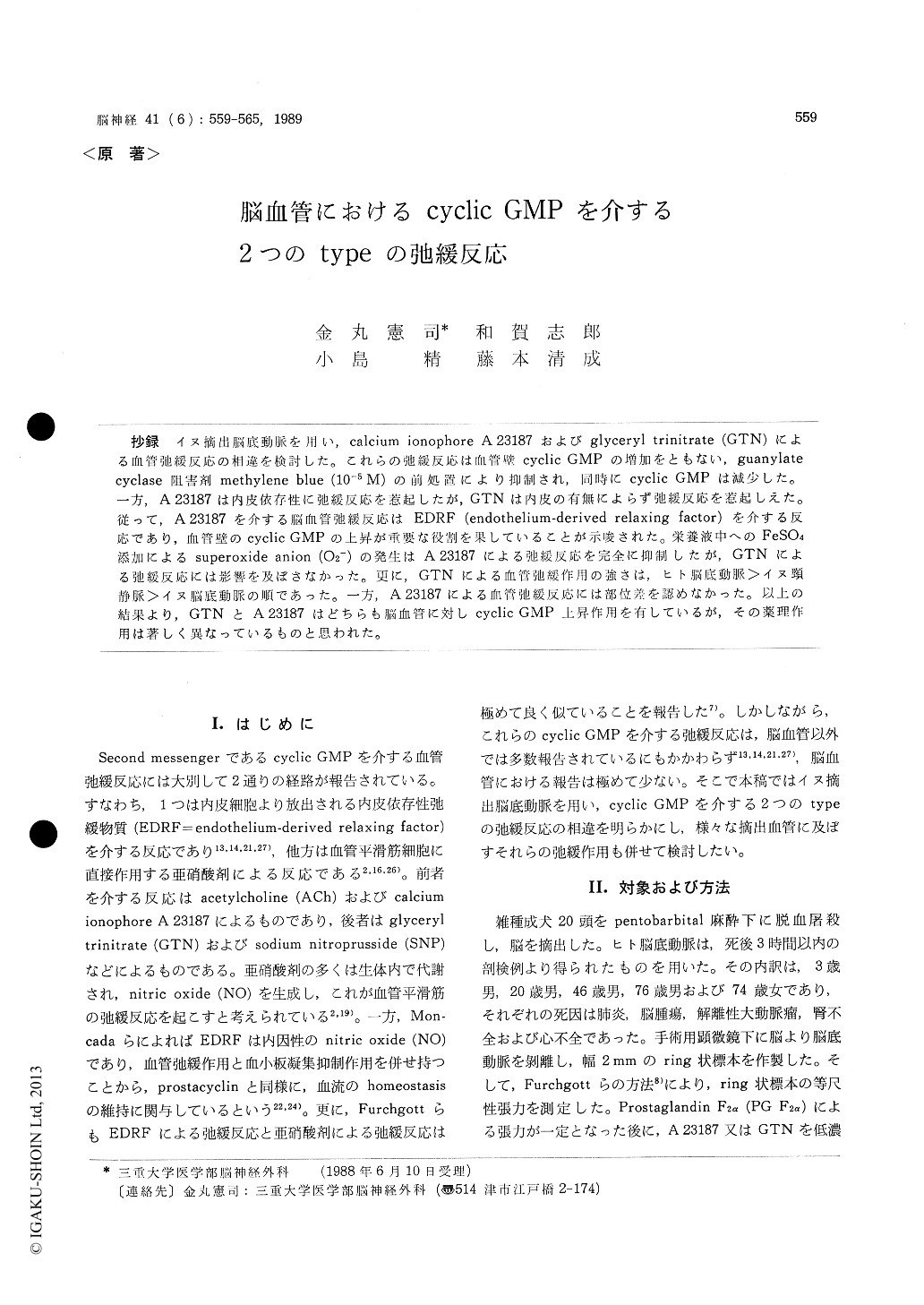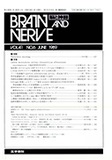Japanese
English
- 有料閲覧
- Abstract 文献概要
- 1ページ目 Look Inside
抄録 イヌ摘出脳底動脈を用い,calcium ionophore A23187およびglyceryl trinitrate (GTN)による血管弛緩反応の相違を検討した。これらの弛緩反応は血管壁cyclic GMPの増加をともない,guanylatecyclase阻害剤methylene blue (10−5M)の前処置により抑制され,同時にcyclic GMPは減少した。一方,A23187は内皮依存性に弛緩反応を惹起したが,GTNは内皮の有無によらず弛緩反応を惹起しえた。従って,A23187を介する脳血管弛緩反応はEDRF (endothelium-derived relaxing factor)を介する反応であり,血管壁のcyclic GMPの上昇が重要な役割を果していることが示唆された。栄養液中へのFeSO4添加によるsuperoxide anion (O2—)の発生はA23187による弛緩反応を完全に抑制したが,GTNによる弛緩反応には影響を及ぼさなかった。更に,GTNによる血管弛緩作用の強さは,ヒト脳底動脈>イヌ頸静脈>イヌ脳底動脈の順であった。一方,A23187による血管弛緩反応には部位差を認めなかった。以上の結果より,GTNとA23187はどちらも脳血管に対しcyclic GMP上昇作用を有しているが,その薬理作用は著しく異なっているものと思われた。
It has been reported that endothelium-derived relaxing factor (EDRF) possesses chemical and pharmacological properties that are indistinguish-able from those of nitric oxide (NO). Moreover, NO is the active chemical species responsible for endothelium-independent vasodilation produced by nitrogen oxide-containing substances including gly-ceryl trinitrate (GTN). Both EDRF and GTN ac-tivate soluble guanylate cyclase and consequently increase cyclic GMP level in various artery prepa-rations. However, there have been few reports regarding cyclic GMP accumulation induced by EDRF or GTN in canine cerebral arteries.
Therefore, it was investigated whether EDRF and GTN cause vasodilation through the common pathway mediated by cyclic GMP in the canine basilar artery. The relaxation responses induced by EDRF or GTN were studied in the canine basilar artery by an isometric tension-recording method.EDRF was induced by calcium ionophore A 23187. A 23187 did not relax the vascular tissue in the absence of the endothelial cells. On the other hand, GTN did induce relaxation in either the pre-sence or absence of endothelial cells. FeSO4 at 3x 10-5 M reversed A23187-induced relaxation, but not GTN-induced relaxation (N=10). Since Fe2+ is able to catalyse the formation of O2- in oxyge-nated phosphate buffer, these findings suggest that Fe2+ antagonizes EDRF by inactivating it via the generation of O2-. By the addition of 10-5 M me-thylene blue, both A 23187- and GTN-induced re-laxations were reversed (N=8). Moreover, pretreat-ment with 10-5 M methylene blue augmented contractile responses to 3 x 10-6 M prostaglandin F2a (N=5).
The cyclic GMP content in canine basilar rings was determined by a sensitive radioimmunoassay procedure. Both A 23187 and GTN elicited an in-crease in arterial cyclic GMP accumulation whichcorrelated well with the development of relaxa-tion. Methylene blue at a concentration of 10-5 M antagonized cyclic GMP accumulation in response to A 23187 and GTN. The inhibitory effect of methylene blue may be due to blockade of guany-late cyclase, as the rise in cyclic GMP contents, which accompanied the relaxation induced by ei-ther of the above agents, was abolished.
The relaxation efficacy of GTN occurred in the order of the human basilar artery>canine jugular vein> canine basilar artery. On the other hand, the relaxation efficacy of A 23187 was not signifi-cantly different among these vessels.
These results suggest that GTN may be a more stable and direct relaxant of the cerebral vascular smooth muscle than EDRF, and that, GTN may be potentially effective in the regulation of cerebral blood flow, especially in the human cerebral artery.

Copyright © 1989, Igaku-Shoin Ltd. All rights reserved.


